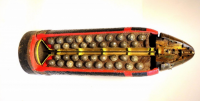








Shrapnel shells were anti-personnel artillery munitions which carried a large number of individual bullets close to the target and then ejected them to allow them to continue along the shell's trajectory and strike the target individually. They relied almost entirely on the shell's velocity for their lethality. The munition has been obsolete since the end of World War I for anti-personnel use, when it was superseded by high-explosive shells for that role. The functioning and principles behind Shrapnel shells are fundamentally different from high-explosive shell fragmentation. Shrapnel is named after Major-General Henry Shrapnel (1761–1842), a British artillery officer, whose experiments, initially conducted in his own time and at his own expense, culminated in the design and development of a new type of artillery shell.
Shrapnel’s invention, perfected by long, private research, consisted of a spherical projectile filled with bullets and fitted with a small charge fired by a time fuse; as the projectile neared the enemy lines, the charge burst the container, and the bullets continued onward in a widening swath. Later versions altered the spherical projectile to a cylindrical shape and increased the bursting charge. The introduction of high-explosive ammunition led to the abandonment of case shot, the violently exploded shell casing itself serving the purpose far better. The term shrapnel continued to be used to designate such shell splinters.